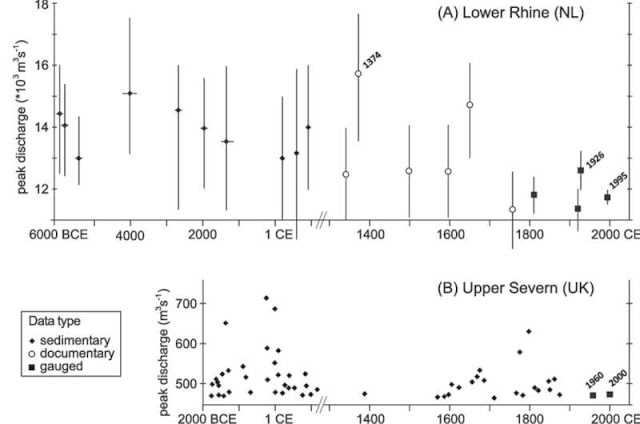Conceptual diagram showing the level of fundamental understanding of extreme events related to weather conditions versus the inferred level of knowledge on how Greenhouse Gases related warming will impact their occurrence and magnitudes– (redrawn after National Academies of Sciences, Engineering, and Medicine, 2016.
Attribution of extreme weather events in the context of climate change. National Academies Press). The blue circles highlight those types of weather extremes that are relevant for the extreme flooding in the NW-European hydroclimatic setting. To the right various often overlooked factors in flood event attribution are summarized.
Credit: Climatic Change (2025). DOI: 10.1007/s10584-025-03904-9Recent "unprecedented" floods are not exceptional if we look further into the past, new research shows.
A team of scientists—led by the University of Exeter—used geological paleo-flood records to examine extreme floods in western Europe over several thousand years.
Published in Climatic Change, the study finds many previous floods exceeded recent extremes, highlighting the need to use these paleo records—not just river gauge data that typically exists for the last century or less.
The researchers challenge the idea that recent floods can be attributed solely to greenhouse gas emissions, but they warn that the combination of natural extremes and global warming could lead to truly extraordinary floods.
"In recent years, floods around the world—including in Pakistan, Spain and Germany—have killed thousands of people and caused enormous damage," said Professor Stephan Harrison, from the Department of Earth and Environmental Sciences at Exeter's Penryn Campus in Cornwall.
"Such floods are seen as 'unprecedented'—but if you look back over the last few thousand years, that's not the case. In fact, floods we call unprecedented may be nowhere near the most extreme that have happened in the past."
Compilation of extreme flood data from NW-Europe, based on gauged, documentary and palaeoflood data.
Frame (A): Measured and reconstructed peak discharges of the Lower Rhine (the Netherlands).
Frame (B): Measured and reconstructed peak discharges for the Upper Severn River (United Kingdom).
Frame (C): Proxy flood magnitudes based on boulder berm deposits in upland catchments in the United Kingdom.
Frame (D): Flood data from Spanish catchments.
Frame (E): Locations of research sites—for the Severn and the Rhine the catchment areas are shown in gray
Credit: Climatic Change (2025). DOI: 10.1007/s10584-025-03904-9
Paleo-flood records use a range of evidence including floodplain sediments, dating sand grains and past movement of boulders to identify past extremes.
Professor Harrison added, "You need that knowledge of the past if you're going to understand the present and make predictions about the future.
"Coupling evidence of past extremes with the extra pressure now being added by human-caused global warming—which causes more extreme weather—you see a risk of genuinely unprecedented floods emerging."
Projects such as housing and infrastructure are built to be resilient to extreme floods—based on assumptions such as a "one-in-200 year" or "one-in-400 year" flood event.
"If we rely on relatively short-term records, we can't say what a 'one-in-200 year' flood is—and therefore our resilient infrastructure may not be so resilient after all," said Professor Mark Macklin. "This has profound implications for flood planning and climate adaptation policy."
The study examined paleo-flood records for the Lower Rhine (Germany and Netherlands), the Upper Severn (UK) and rivers around Valencia (Spain). In the Rhine, records for about 8,000 years show at least 12 floods that are likely to have exceeded modern peaks.
The Severn analysis shows that floods in the last 72 years of monitoring are not exceptional in the context of paleo-flood records of the last 4,000 years. The largest flood in the Upper Severn occurred in about 250 BCE and is estimated to have had a peak discharge 50% larger than the damaging floods in the year 2000.
The Life of Earth
https://chuckincardinal.blogspot.com/



No comments:
Post a Comment
Stick to the subject, NO religion, or Party politics